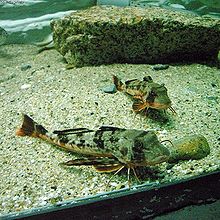Triglidae
| Triglidae | |
|---|---|

| |
| Spiny red gurnard, Chelidonichthys spinosus | |
| Scientific classification | |
| Domain: | Eukaryota |
| Kingdom: | Animalia |
| Phylum: | Chordata |
| Class: | Actinopterygii |
| Order: | Scorpaeniformes |
| Suborder: | Platycephaloidei |
| Family: | Triglidae Rafinesque, 1815[1] |
| Subfamilies | |
|
see text | |
Triglidae, commonly known as gurnards or sea robins, are a
Taxonomy
Triglidae was first described as a
Etymology
Triglidae's name is based on that of Linneaus's genus Trigla, the name of which is a
Subfamilies and genera
Triglidae is divided into 3 subfamilies and 9 genera as follows:[3][1][2]
- Prionotinae Kaup, 1873
- Pterygotriglinae Fowler, 1938
- Bovitrigla Fowler, 1938
- Pterygotrigla Waite, 1899
- Triglinae Rafinesque, 1815
- Chelidonichthys Kaup, 1873
- Eutrigla Fraser-Brunner, 1938
- Lepidotrigla Günther, 1860
- Trigla Linnaeus, 1758
These subfamilies have been given the rank of tribe, Prionotini, Pterygotriglini and Triglini, by some authorities. Prionotinae are regarded as the basal grouping with Triglinae being the most derived.[8]
Characteristics
Triglidae gurnards have mouths which are either terminal or positioned slightly below the snout, which has its tip normally having paired rostral projections, frequently armed with spines, and these create the impression of a 2 lobed snout when seen from above. There are no barbels on the head and the preorbital bones typically project forward. The lower 3 rays of the
Most species are around 30 to 40 cm (12 to 16 in) in length with the females typically being larger than the males.[10] They have an unusually solid skull, and many species also possess armored plates on their bodies. Another distinctive feature is the presence of a "drumming muscle" that makes sounds by beating against the swim bladder.[11] The length of the swim bladder had a negative correlation to gonadal development. A sexual dimorphism of swim bladder size is created due to the negative correlation being stronger in females then in males.[12]
Sea robins have three "walking rays" on each side of their body.
Survival and Reproduction
Classified as carnivores, gurnards mainly feed on crustaceans. Most species are opportunistic predators and will feed on prey such as teleost and mollusks as well.[18] Gurnards do not have a primary predator; however, larger fish, marine mammals, birds, and humans will prey on gurnards.[19] They are bottom-dwelling fish, living down to 200 m (660 ft), although they can be found in much shallower water. When it comes to preferred water depths, adult gurnards will favor deeper water while juveniles will favor shallower water.[20] The different genera of gurnards have diverse offspring spawning periods, varying in length and time of year. Some examples are, tub gurnard spawning period takes place from December to March, and red gurnard spawning takes place from September to May.[21][22]
As food
Gurnard have firm white flesh that holds together well in cooking, making them well-suited to soups and stews. They are commonly used in the French dish bouillabaisse. One source describes gurnards as "rather bony and lacking in flavour";[23] others praise its flavour and texture.[24]
They were often caught in British waters as a bycatch and discarded. However, as other species became less sustainable and more expensive they became more popular,[25] with the wholesale price between 2007 and 2008 reported to have increased from £0.25 per kg to £4, and sales increasing tenfold by 2011.[24] Gurnards also are now appearing in fish markets in the U.S.
Angling
Sea robins can be caught by dropping a variety of baits and lures to the seafloor, where they actively feed. Mackerel is believed to be the most efficient bait for catching sea robins, but crabs, bunker and other fish meat can also be used successfully depending on location. Sea robins can also be caught by lure fishing if lured near the substrate. They are often considered to be rough fish, caught when fishing for more desirable fish such as striped bass or flounder.[26] Gurnard are also used as bait, for example by lobster fishermen.[24]
References
- ^ PMID 25543675.
- ^ a b c Eschmeyer, William N.; Fricke, Ron & van der Laan, Richard (eds.). "Genera in the family Triglidae". Catalog of Fishes. California Academy of Sciences. Retrieved 26 May 2022.
- ^ ISBN 978-1-118-34233-6.
- PMID 28683774.
- ^ Christopher Scharpf & Kenneth J. Lazara, eds. (10 June 2021). "Order Perciformes (Part 12): Suborder Triglioidei: Families Triglidae and Peristediidae". The ETYFish Project Fish Name Etymology Database. Christopher Scharpf and Kenneth J. Lazara. Retrieved 26 May 2022.
- ^ "Sea robin". Collins. Retrieved 26 May 2022.
- ^ "Gurnard". Merriam-Webster Online. Retrieved 18 June 2012.
- doi:10.1071/MF01128.
- ^ Froese, Rainer, and Daniel Pauly, eds. (2022). "Triglidae" in FishBase. February 2022 version.
- ISSN 1727-3048.
- ISBN 0-12-547665-5.
- JSTOR 1444436.
- ^ PMID 32709626.
- ^ Kuntz, A. and L. Radcliffe (1918). "Notes on the embryology and larval development of twelve teleostean fishes". Bulletin of the Bureau of Fisheries. 35: 87–134.
- PMID 17620306.
- ^ Bardach, J. & Case, J. Sensory capabilities of the modified fins of squirrel hake (Urophycis chuss) and searobins (Prionotus carolinus and P. evolans). Copeia 1965, 194–206 (1965)
- ^ Silver, W. L. and T. E. Finger (1984). "Electrophysiological Examination of a Non-Olfactory, Non-Gustatory Chemosense in the Searobin, Prionotus-Carolinus." Journal of Comparative Physiology 154(2): 167–174.
- ISSN 2475-0263.
- ISBN 0-7803-8669-8.
- .
- ISSN 1323-1650.
- ISSN 1727-3048.
- ^ "Gurnard".
- ^ a b c "Ugly fish, tasty dish: chefs extol the sustainable virtues of the gurnard". 22 October 2011.
- ^ "Gurnard recipes - BBC Food".
- ^ Victor Bonato. "Taking out the trash". Archived from the original on 2016-03-04. Retrieved 2015-01-11.
